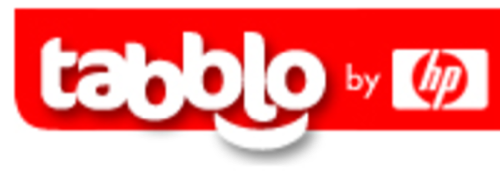Big computing company HP was promoting a strange concept at the Web 2.0 Summit in October: Print 2.0. At first I couldn’t figure out what this meant. Web-based printers? Some new form of inkless paper? Curious to know more, while I was at the Summit I met up with HP’s Antonio Rodriguez – formerly of startup Tabblo, now Director of Research and Development for HPÄôs embedded web-to-print group.

Some background: Tabblo is a custom printing site that HP acquired in March 2007. In our meeting, Antonio described Tabblo to me as “Flickr meets blogger on steroids”. Using Tabblo, you can mashup photos and add text, to create a kind of collage – which you then have the option to print out as a poster, book, card, etc. The collage is also available online, where other Tabblo users can comment on it. There are a lot of other features too, such as advertising options and widget-like tools. At the heart of Tabblo is its template engine, which allows users to output their creative photo collages both online and as printed materials. Here’s a good example of a Tabblo collage, from someone’s birthday party. Here’s another example, via Flickr:

The tale of how Tabblo got acquired is interesting in itself – and a great example of the process a startup might take before being acquired by a big company. Tabblo got its funding in June 2005, went into alpha March 2006, then beta at the end of May 2006, finally hitting 1.0 in July 2006. It was acquired less than a year later. So from funding to acquisition, less than 2 years. But importantly it was a useful web app with a healthy user base. Om Malik summed it up well at the time of acquisition, noting that Tabblo had “made a tool that incorporated the best of social web and built a layer of usefulness on top of that. And focused their product on mainstream users.”
So in summary, Tabblo was a great web 2.0 product that made the step up to big company app. In doing so, it seems to have inspired Print 2.0 inside of HP. Well, there is probably much more to the Print 2.0 conception, but Tabblo is what makes the concept make sense and come alive. Sometimes big companies come up with lots of PR bluster and crazy concepts (and nowadays there’s usually a “2.0” in the PR), but at the heart of it there has to be something that connects with consumers. Tabblo is that thing, with HP’s Print 2.0 story.
Printing Becomes a Service Too
HP acquired Tabblo with the aim of making printing from the Web easier. For example, webpages are sometimes difficult to print (R/WW is guilty on that count!). In terms of the big picture, Antonio explained to me that the print business is huge, but that HP is starting to think in terms of digital devices now – rather than the old model of [paper] pages. So in terms of products, HP’s Print 2.0 strategy is about delivering products and services such as the Tabblo Print Toolkit – which enables publishers to provide template-based PDFs of their webpages for easy printing.
HP also wants to get into the on-demand printing business, where it will face competition from the likes of Amazon.com and Lulu.com. Antonio told me that the vision is for a self-serving site to create books. However he said that there are practical issues holding this up, such as DRM.
There are also partnership deals. At Web 2.0 Summit HP announce that its Print 2.0 technology has been integrated into Flickr, allowing Flickr users to easily print their photos. HP did a deal too with Disney, allowing users to combine professional Disney content with their own personal content – and print it out. The Graffiti Application for Facebook, where users can draw on their friends profiles, was also print-enabled by Tabblo.
Ultimately HP wants to make printing a service – I suppose much like Microsoft wants to make its software into services. HP wants to make printing more personal and social; which brings us back to Tabblo’s legacy. It did precisely that, make printing personal and social. But HP wants to do it on a much larger scale. This is why big companies build startups of course!
What do you think of HP’s Print 2.0? Does it make more sense now that you know the Tabblo story?










